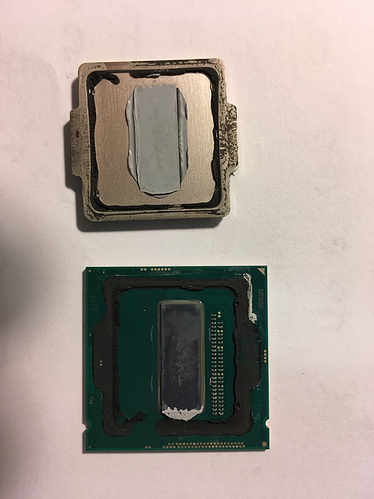Ok. That was exciting.
The good news is I am writing this from patient zero!
Here’s the steps I took, to document it for the record (just in case patient zero ever gets a lawyer):
First off, here was my issue. When I stress my PC, like for CPU intensive gaming like flight sims, then my overclock of 4.5 GHz was running too hot. I put it back to defaults of 3.6, with a Turboboost of 3.9 on the single core, but it was (a) still too hot and (b) made me feel sad, because it was slower than I was used to for the last year or so. Here’s a rough temp profile pre-operation:
So the ‘70C+’ spike was the CPUZ plain ‘Stress’ text, to max the CPU cores for 1 minute. It would essentualy just escalate up to about 85C, causing me to stress out.
Step 1. Take off the existing cooler. The thermal paste I used last was Arctic Silver 5, and it looks still pretty good here (albeit a bit uneven under the water block when I took it off):
Step 2. Get that puppy prep’d for the op. Here’s the hot boy himself:
Step 3. Off With Their Head! After a quick Isopropyl alcohol 99% rub down refreshing I put it in the Vice of Justice.
Step 4. Looking at it, it seemed wrong. Why would I put all the pressure on those lips sticking out the side. That can’t be right. Using advanced Vulcan logic I managed to figure it out and rotated it to the proper orientation here (flat sides against vice edge):
Step 5. Squeaky Bum Time. I turned the allen key. I turned it some more. Nothing.
I really turned it, like it’s a ‘him or me’ mano a mano fight now. Not budging.
(click).
Ok, something moved. Thank the maker. I think I see and edge come up a bit.
Step 6. The Completely Safe Razor Blade Technique. To cut the glue I edged a blade under a corner, like so:
I still have the vast majority of my fingers, so a win there. Plus if I’m ever lifted for prints then I can just look on the floor for them.
Step 7. The Intel Autopsy. Once some considerable force was used to pry apart the glue on integrated heat panel, I see this:
Hmm. Look at that, the actual chip is as clean as a whistle. The TIM on the IHT is rock hard and more like a plastic resin. I think this stuff was really dried out after all these years.
Step 8. Clean Up and Nails. I removed the bad paste but kept the old glue, as it would act as a guide for me putting this back together, plus I left an outline of the old TIM so I could know the boundary of where to put the new liquid metal. I used an edge of credit card to scrape it, which would come in handy when I need to buy a new computer as well. This might work with VISA or Mastercard, but no guarantees.
I then put a very thin layer of nail varnish on the capacitor pegs on the left of the actual chip (above it in the pic above). I did that because I don’t want the liquid metal squeezing off the chip or IHT and then joining all those circuits up in an hilarious 3 volt explosion. Johnny 5 would not be alive if that happened. I spent a pleasant 15 minutes blowing on my chip to dry my nail vanish. It looks fantastic! 
Step 9. The Terminator 2 Arrives. Using liquid metal is scary, just because even without referring to a valence ions table, I’m pretty sure this stuff conducts electricity. Pouring it over a naked chip sounds bad. I start with the IHT, and use the syringe to put the smallest blob I can on it:
That really really spreads out a lot. I get it so there is no moving liquid, and try to keep the outline of the old TIM, as the chip is not actually symmetrically in the middle of the glued area. I used a ruler to check, being all sciency and whatnot.
Ok, time for a tiny amount on the chip.
This actually spreads out really nicely. I use a fine brush to move the metal around. It felt like painting a small figurine or toy soldier. Fun. I now have a Disco-Intel ™.
Step 10. Reassemble. I didn’t bother getting glue and sticking the IHT and chip back together. The motherboard clamps them pretty tight, and as this was my first time I was just suspecting that (a) it wouldn’t even boot and (b) I’d probably have to do this again and didn’t want to go through that vice bit with better/newer glue.
I put the naked chip back in the motherboard and then place the IHT VERY CAREFULLY on top:
I then locked down the clamp, by keeping a finger firmly on the chip while I pressured the arm down. This bit was fairly risky.
Ok, I was very tempted to use liquid metal on the outside IHT and the water block (I still might actually) but was keen to see if this would actually ever boot up again, so just used a very small amount of artic silver 5 paste and put it back together.
It boots!
It is running cooler!
Time for some experiments, but so far, it is not worse. My hypocritical oath  of “do not so much harm, unless it’s fun and you can get away with it” is working. Will report back later, just now need to finish this 99% alcohol and clean up paste from my fingers.
of “do not so much harm, unless it’s fun and you can get away with it” is working. Will report back later, just now need to finish this 99% alcohol and clean up paste from my fingers.




















